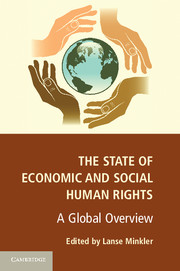Book contents
- Frontmatter
- Contents
- Contributors
- Acknowledgments
- 1 Introduction: Why Economic and Social Human Rights?
- I CORE RIGHTS
- II NONDISCRIMINATION
- III META
- 10 Establishing a Social and International Order for the Realization of Human Rights
- 11 Beyond a Minimum Threshold: The Right to Social Equality
- 12 The Right to Development from a Human Rights Approach: Conceptual Bases, Legal Framework, and Contemporary Challenges
- 13 Constitutional Environmental Human Rights: A Descriptive Analysis of 142 National Constitutions
- 14 Conclusion: Reflections on the Theory and Practice of Economic and Social Rights
- Index
- References
11 - Beyond a Minimum Threshold: The Right to Social Equality
Published online by Cambridge University Press: 05 February 2013
- Frontmatter
- Contents
- Contributors
- Acknowledgments
- 1 Introduction: Why Economic and Social Human Rights?
- I CORE RIGHTS
- II NONDISCRIMINATION
- III META
- 10 Establishing a Social and International Order for the Realization of Human Rights
- 11 Beyond a Minimum Threshold: The Right to Social Equality
- 12 The Right to Development from a Human Rights Approach: Conceptual Bases, Legal Framework, and Contemporary Challenges
- 13 Constitutional Environmental Human Rights: A Descriptive Analysis of 142 National Constitutions
- 14 Conclusion: Reflections on the Theory and Practice of Economic and Social Rights
- Index
- References
Summary
Introduction
Over the past two decades, a growing number of human rights scholars and practitioners have focused on defining the content of the economic and social rights guaranteed in the Universal Declaration of Human Rights (UDHR) and the International Covenant on Economic, Social and Cultural Rights (ICESCR), as well as other international human rights instruments. Numerous works now elaborate on the “minimum core content” of these rights, which grouped together form an international human rights-based poverty line (CESCR 2001; Chapman & Russell 2002; Vizard 2006; Bilchitz 2007). Some works also explore the idea of an “adequate” level of social rights, as explicitly guaranteed in the UDHR and the ICESCR (UDHR Article 25; ICESCR Article 11). Both of these approaches to defining economic and social rights describe the content of the rights in terms of a minimum threshold to which a person is entitled without much, if any, regard for the overall equality in the enjoyment of these rights by the people within a society.
Yet, today there is mounting evidence indicating that economic and social inequality adversely affect many dimensions of people's lives (Commission on the Social Determinants of Health [CSDH] 2008; Wilkinson 2005). Indeed, a growing number of studies show that more unequal societies have higher homicide rates; lower life expectancies; lower average standards of health; greater discrimination against women, racial minorities, and other marginalized groups; and lower participation in elections (Wilkinson 2005). These dimensions correlate strikingly closely to human rights recognized in international human rights legal instruments, including the rights to life, health, nondiscrimination, personal security, and political participation. Thus, the research suggests that economic and social inequality adversely affects the enjoyment of human rights. In view of this evidence, it is timely to consider the extent to which the International Bill of Human Rights encompasses a guarantee of some level of economic and social equality – just as it guarantees some level of civil and political equality.
- Type
- Chapter
- Information
- The State of Economic and Social Human RightsA Global Overview, pp. 271 - 305Publisher: Cambridge University PressPrint publication year: 2013
References
- 23
- Cited by

